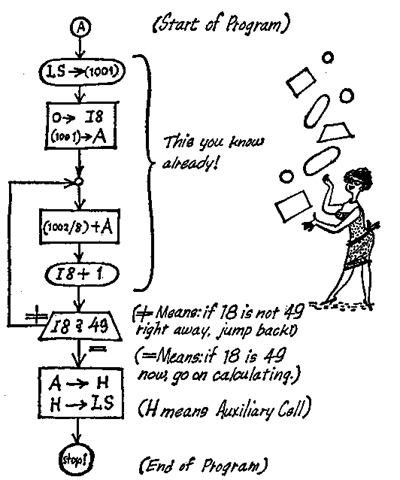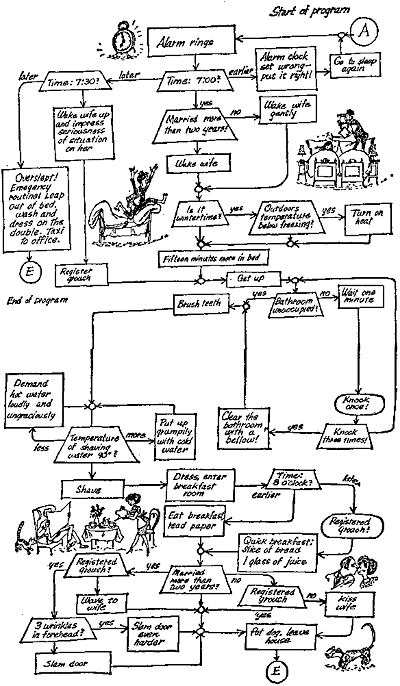The seven nines
We have already mentioned the "Stop!" instruction, which in the "ER 56" is always "7900 0 00" and brings the computer to a halt. And if you have followed our reasoning so far, you now know why we chose the storage address (0610) and no other as an auxiliary cell: at (0609) the program is over, and (0610) is the next free cell. As it must remain free for the result of the calculation, a chain of seven zeros is stored in it first of all, instead of an instruction.
But what on earth is the instruction "9999 9 99" in the storage cells (0611) and (0612) supposed to mean? Didn't our program end long ago?
But that is just what these seven nines mean. In the "ER 56" they are the "omega word" (similar combinations are used in other computers). Omega is the "Z" of the Greek alphabet, its last letter. The omega word says to all the machine units concerned; "Here comes the final 'Stop!' instruction - now it´s all over!" Seven nines, punched twice in the tapes, mean only one thing to input and to output alike: "Switch off!" The punched tape reader stops after it has brought the two "9999 9 99"s into the storage cells (0611) and (0612). In the same way the tape punch stops after it has punched the omega word in the paper tape. And the teleprinter, through which the punched tape then runes, switches off after it has recognized both the sequences of nines.
There are problems which baffle even experienced programmers! In such tougher cases, the programmers do not generally put down the symbolic instructions at once in a detailed list. They prepare a "flow chart" beforehand, a plan - sometimes merely in rough outlines - specifying the procedure to be followed by the calculation.
If a flow chart were necessary for our cyclic adding program, it would look something like that:

Some statements are enclosed in boxes with sharp corners and others in round ones, and this is not just a whim of the artist who made our drawings. She simply followed the international language commonly used by programmers. Statements in rectangular boxes mean: "This is where an arithmetical operation is going on!" Purely organizational instructions are to be found in rounded compartments, and boxes with slanting short sides looking like reefs contain matters concerning decisions. To save programmers all over the world the trouble of drawing square, round and bevelled boxes, they buy and we stencils for them.
If you compare the flow chart just drawn with the sequence of symbolic instructions on "The language is simple", you will feel inclined to say: "But there's practically no difference!"
You are quite right. Our adding program is so simply constructed that even the flow chart can hardly be more straightforward than the sequence of instructions. In complicated programs, matters are otherwise. There, the flow chart represents nothing but a logical sketch, still to be worked out in all its details to form a list of instructions.
So that you can clearly see just what it is possible to include within the compass of a flow chart, we shall turn aside from the path of science for a short spell and make our way to the Plains of Higher Nonsense. In our next Illustration will find a flow chart of the kind that programmers love to work out for themselves when their employers do not happen for the moment to be looking their way.

(HERE you can see the Illustration a bit
better)
Flow chart with symbolic instructions >>>>
©
by PhiloPhax & Lauftext
& Redaktion Lohberg
Kybernetik
- Was ist das?
First printed in Germany: 1963